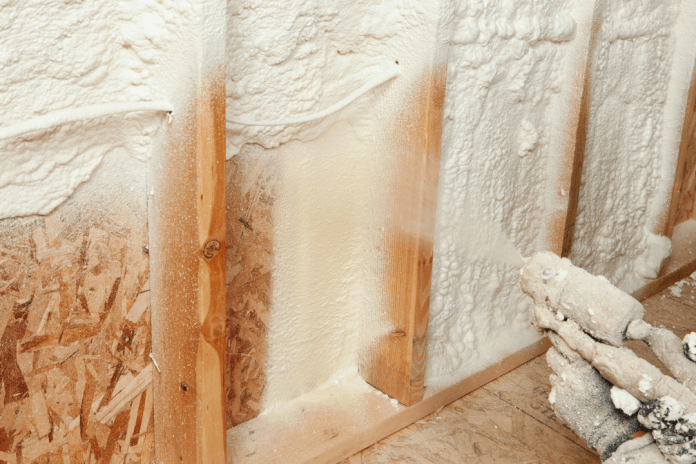When considering spray foam insulation for your home, one of the critical factors to understand is the process of off-gassing. Off-gassing refers to the release of volatile organic compounds (VOCs) from the materials used in the spray foam, which can impact indoor air quality and overall health. In this article, we’ll explore how long spray foam insulation off-gases, what factors influence this process, and how you can minimize any potential risks.
Understanding Off-Gassing in Spray Foam Insulation
Off-gassing is a common phenomenon that occurs when chemical compounds, particularly VOCs, are released into the air from various materials. Spray foam insulation, composed of isocyanates and polyol resin, undergoes a chemical reaction when applied, expanding into a foam that hardens to form a protective barrier. This process is also relevant for spray foam insulation in existing walls, where the foam expands to fill gaps and create an airtight seal. During the curing process, VOCs are released, leading to off-gassing.
The Initial Off-Gassing Phase: What to Expect
Immediately after installation, spray foam insulation undergoes its most intense phase of off-gassing. This period is known as the curing phase, during which the foam hardens and the majority of VOCs are released. The initial off-gassing phase typically lasts for about 24 to 72 hours. During this time, it is crucial to ensure proper ventilation in the area where the spray foam has been applied to reduce the concentration of VOCs in the air.
Factors That Affect Off-Gassing Duration
Several factors can influence the duration and intensity of off-gassing in spray foam insulation:
1. Type of Spray Foam
There are two main types of spray foam insulation: open-cell and closed-cell. Closed-cell spray foam tends to off-gas more slowly due to its denser structure, while open-cell foam may off-gas more quickly.
2. Application Conditions
The conditions under which the spray foam is applied, such as temperature and humidity, can also impact the off-gassing process. Higher temperatures and humidity levels can accelerate the curing process, potentially reducing the duration of off-gassing.
3. Quality of Materials
The quality of the spray foam material plays a significant role in off-gassing. High-quality, low-VOC spray foam products are designed to minimize off-gassing and provide a safer indoor environment.
4. Ventilation
Proper ventilation during and after the installation of spray foam insulation is crucial in mitigating the effects of off-gassing. Adequate air circulation helps disperse VOCs more quickly, reducing the overall exposure time.
Long-Term Off-Gassing: Is It a Concern?
While the majority of off-gassing occurs within the first few days of installation, there may be a concern about long-term off-gassing. After the initial curing phase, the rate of VOC emission decreases significantly, but small amounts may continue to be released over time. However, with proper installation and ventilation, the long-term effects are generally minimal and unlikely to pose significant health risks.
Health Implications of Off-Gassing
Exposure to VOCs during the off-gassing process can lead to various health symptoms, particularly in individuals with sensitivities or pre-existing conditions. Short-term exposure to high levels of VOCs may cause headaches, dizziness, nausea, and irritation of the eyes, nose, and throat. Long-term exposure, even at lower levels, can lead to more severe health issues such as respiratory problems, allergic reactions, and in some cases, neurological effects.
How to Minimize Off-Gassing Risks
To minimize the risks associated with spray foam insulation off-gassing, consider the following strategies:
1. Choose Low-VOC Products
Opt for spray foam insulation products that are specifically labeled as low-VOC. These products are formulated to emit fewer VOCs during and after the installation process, making them a safer choice for your home.
2. Hire a Professional Installer
Professional installation is key to ensuring that spray foam insulation is applied correctly and safely. Experienced contractors will follow best practices, including proper mixing, application, and ventilation, to minimize off-gassing.
3. Ensure Proper Ventilation
During the initial curing phase, it’s essential to ventilate the area well. Use fans and open windows to allow fresh air to circulate, which helps dissipate VOCs more rapidly.
4. Allow Adequate Curing Time
Avoid occupying the space where spray foam has been applied until the initial curing and off-gassing period is complete. Waiting at least 24 to 72 hours before returning to the area can significantly reduce exposure to VOCs.
Environmental Impact of Off-Gassing
The environmental impact of off-gassing is an important consideration for eco-conscious homeowners. While VOCs contribute to indoor air pollution, advancements in spray foam technology have led to the development of products that emit fewer VOCs and have a reduced environmental footprint. Additionally, the energy efficiency benefits of spray foam insulation can offset its environmental impact by reducing overall energy consumption and greenhouse gas emissions.
The Role of Building Codes and Regulations
In many regions, building codes and regulations govern the use of spray foam insulation to ensure safety and minimize health risks. These codes may specify requirements for ventilation, product selection, and application methods to reduce the potential for off-gassing. Homeowners should be aware of local regulations and work with a contractor who is knowledgeable about compliance.
How to Test for VOC Levels After Installation
If you’re concerned about VOC levels after spray foam insulation installation, testing can provide peace of mind. There are various methods to test for VOCs, including:
- Air Quality Monitors: Portable devices that measure VOC levels in your home.
- Professional Testing Services: Hiring a professional to conduct thorough air quality testing can provide more detailed information.
Conclusion: Managing Spray Foam Insulation Off-Gassing
Understanding and managing off-gassing is essential when considering spray foam insulation for your home. While the initial off-gassing phase is the most intense, proper product selection, installation, and ventilation can minimize risks and ensure a safe and comfortable living environment. By taking the necessary precautions, you can enjoy the many benefits of spray foam insulation, including improved energy efficiency, moisture control, and indoor air quality, without compromising your health or the environment.
